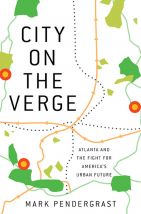City on the Verge: Atlanta and the Fight for America’s Urban Future

Akin to delving into a good novel, City on the Verge narrates the story of the BeltLine project in Atlanta since its inception in 1999 as a Master’s thesis. Resurrected in 2001 as a grassroots movement, this visionary project transforms a 22-mile ring of mostly defunct railroads into an “emerald necklace” consisting of pedestrian walkways, park connectors, bike trials and streetcar lines around the city (page X). However, City on the Verge is more than a detailed narrative of this project, which is expected to take a couple of decades to complete (page xiv). Rather, the BeltLine reflects greater forces facing American cities in general, and acts as a framework for Mark Pendergrast to explore these forces in Atlanta and its surrounding region. Pendergrast also describes the BeltLine as representing a tipping point for Atlanta’s urban reality. It offers an opportunity for Atlanta to rejuvenate itself and by doing so to set a precedent for other American cities – or, should it not be fully implemented, to mark Atlanta’s slow dissolution “into an amorphous urban shell” (page xi).
The book is structured in two parts. The first part, “Building the BeltLine”, comprises a prologue followed by nine chapters. Certain chapters provide “an unbroken linear narrative of the BeltLine’s evolution and struggle”, while others “offer expansive perspectives on Atlanta’s history, transportation and racial issues, housing, public health, urban planning, education and more” (page xviii).
The second part, “Neighbors”, comprises six chapters. The first four chapters focus on individual neighbourhoods alongside the BeltLine. The penultimate chapter then examines areas outside and inside the BeltLine to highlight just how different they are: one representing the city of Atlanta, with a population of only 454,000 people in 2016, and the second representing the metro region of Atlanta, which has over 6 million inhabitants (page 243). The final chapter looks forward to Atlanta’s future and gives a more critical perspective of the BeltLine, whilst still upholding its vital role for Atlanta’s rejuvenation into a more liveable city. Here Pendergrast concludes that although Atlanta’s future and the BeltLine’s completion remain uncertain, this city is still “full of potential, hype and hope” and thus continues to be a “city on the verge” (page 289).
City on the Verge is relevant for city planners, policymakers, practitioners and students of urban development, social activists and grassroots organizations, and anyone with an interest in Atlanta or the future potential for sprawling American cities to become walkable, renewed places with vibrant inner-city areas. Although using a transit line to facilitate the project, neither the BeltLine nor this book is a study of transportation policy and practice. Rather, the book looks at how changes in land use and connectivity provided through the BeltLine project affect issues of “transportation, race, housing, education, religion, the environment, energy, public health, business, politics, and the economy” (page xiv) – in other words the sustainability of Atlanta as a whole.
Book note prepared by Hannah Keren Lee
Search the Book notes database
Our Book notes database contains details and summaries of all the publications included in Book notes since 1993 - with details on how to obtain/download.
Use the search form above, or visit the Book notes landing page for more options and latest content.
For a searchable database for papers in Environment and Urbanization, go to http://eau.sagepub.com/

